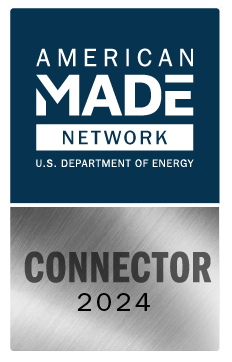CLEVELAND, Ohio – The shift from gasoline-fueled engines to fully electric vehicles could be an opportunity, and a threat, to Ohio’s economy. But there’s reason to believe the Buckeye State is in the driver’s seat.
Automakers are spending billions of dollars to shift from gasoline. Electric vehicle manufacturing could create thousands of new jobs, but it could also make thousands of jobs tied to making gasoline-powered vehicles obsolete.
That’s why Ohio is fighting, successfully so far, to get electric vehicles built in Ohio.
“It’s an exciting time,” said Rick Stockburger, president and CEO of BRITE Energy Innovators, a business incubator based in Youngstown. “We’re seeing a change in the market forces. Ohio can either take advantage of it and lead or wait and continue to fall behind.”
There are 91,600 auto jobs in Ohio — either assembling vehicles or making parts, according to the latest data from August. That’s down from August 1990, when Ohio had 144,000 auto jobs. But the state still has the second largest automotive workforce in the country, according to U.S. Bureau of Labor Statistics Data.
The auto industry is in flux. Companies are racing to design, build and mass-market electric vehicles. And that’ll mean a lot of changes to their supply chains in the next few decades, said Ned Hill, an economic development professor at Ohio State University and former dean of Urban Affairs at Cleveland State University.
How fast they go from gasoline-fueled internal combustion engines, often called ICE vehicles, to electric vehicles is an open question. General Motors said it will sell electric vehicles exclusively by 2035. And California regulations would phase out the sale of gas vehicles in about 12 years.
But drivers will have the final say, and plenty of people are skeptical about a transition that fast.
Automakers throw billions at electric vehicles
Auto companies are spending money right now to change their operations, including in Ohio.
Ford says it will spend $22 billion through 2025 on electric vehiclesand committed to a $1.5 billion investment that would shore up the Ohio Assembly Plant’s future in Avon Lake to build electric vehicles. GM says it will spend $35 billion to electrify through 2025 and committed to a $760 million conversion of its transmission factory in Toledo into a facility that makes electric-drive units.
GM and LG Chem spent more than $2 billion to build Ultium Cells, a battery plant, in Lordstown. And Honda and LG on Tuesday announced a $4.2 billion plan to build an electric-vehicle battery plant in Fayette County south of Columbus and retool Honda’s existing plants in Ohio to make electric vehicles.
Electric vehicles look like their gasoline-powered counterparts. But Scott Colosimo, CEO of the e motorcycle maker LANDin Cleveland, said manufacturing them is a different story.
“It’s like going from horse and buggy to gasoline cars,” he said. “There’s a massive difference.”
An electric vehicle doesn’t have an exhaust system, or a complex transmission. And a typical combustion enginewill have many more parts than an electric motor.
Electric vehicles will need unique parts — batteries, power inverters, onboard chargers and complex wiring systems — but in total will use fewer components than an ICE vehicle.
Even the batteries, Stockburger said, will undergo many changes in the next decade.
Colosimo said startups, like LAND, will begin from scratch with EVs. They’ll use advanced technology like CNC bending machines and laser cutters, opting for flexibility.
The big players, like Ford and GM, are more likely to “copy and paste” their old methods as they make the switch, Colosimo said.
Any vehicle, whether its gas-powered or electric, takes thousands of parts. Automakers handle big ticket items and assemble vehicles, but they look to other companies, big and small, to fill out the supply chain.
And many parts come from overseas. Colosimo said there are many small parts, like headlights, turn signals and other simpler electronics, that are mostly imported.
Some industries, like battery technology, are dominated by international companies like LG Chem.
And parts that take a lot of labor to make, like electric motors, are usually offshored, Hill said.
Hill said automakers will likely bring some of these capabilities in house, like motors. And it makes sense to build heavier items, like batteries, near the assembly plants in the U.S. But the supply chain itself will be overhauled in anticipation of electric vehicles.
Jonathan Bridges, managing director of automotive at JobsOhio, said leaders in economic development feel pressure to bring new jobs to the state amid this transition. But they also feel like they have a competitive advantage.
“This is the perfect opportunity for us to show what were made of,” Bridges said.
Ohio’s location and workers give it a boost
Ryan Augsburger, president and CEO of the Ohio Manufacturers Assocation, said Ohio has several things working to its advantage.
One advantage is proximity. Especially with the heavy batteries needed in electrical vehicles, being close to assembly plants and having ample highway and rail access is a plus.
So is the existing workforce. He said many workers will need to be retrained. But finding workers is one of manufacturers’ biggest challenges.
“If we can be the state that gets manufacturing workforce right, look out,” Augsburger said.
The bulk of Ohio’s auto jobs, about 68,000 of the 91,000, are in making parts. Many more are employed in plastic and rubber, metal and electronics manufacturing.
Their success is tied to the success of the transportation industry in Ohio, Augsburger said. Gas-powered vehicles going away could cause a ripple effect felt across several industries.
“To say that Ohio has a lot of risk would be a gross understatement,” Augsburger said.
Bridges said automakers aren’t running away from their workforces, they’re doubling down on them. Companies with a presence in Ohio, like Ford, Honda and GM, are putting more money into the state. And they’re converting gasoline-powered vehicle jobs into electrical-vehicle jobs.
And manufacturers from overseas, like Foxconn and LG Chem, are choosing to enter the state.
“I think it is a two-edged sword, and I think we’re in the best position possible,” Bridges said.
There are other pros, Augsburger said. Ohio has an attractive business environment when it comes to taxes, infrastructure and access to electricity, he said. And there’s access to fresh water, which is needed to make batteries.
Ohio’s “bread and butter” is the powertrain — it makes stuff that makes vehicles move. And the “moving” part of vehicles is what’s changing the most.
JobsOhio is pushing for EV jobs, but it isn’t abandoning companies in the gasoline-car supply chain either.
Some companies will move to electric vehicles ahead of time, but that won’t make gasoline-powered vehicles go away, Bridges said. And the businesses that stay in the ICE-vehicle market can pick up more customers. JobsOhio will support those companies too, Bridges said.
“Both of those companies are viable, and both of those companies are going to be successful,” Bridges said.
Both Bridges and Augsburger didn’t say the future necessarily means going all in on electric vehicles. They’re the buzz right now, but whether consumers quickly gravitate to them is an open question. And another technology, like hydrogen-powered vehicles, could make leaps and bounds.
“We see Ohio as the vehicle state, past, present and future,” Augsburger said. “And we are supporting policies to make sure we continue to be the vehicle state.”
Read the full Cleveland.com article here.





